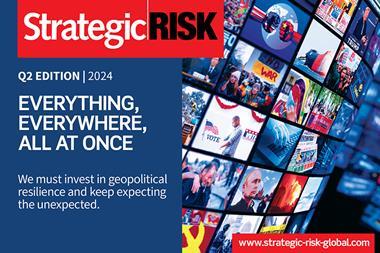As Charlotte Hedemark takes up her dream role as FERMA president, she tells StrategicRISK editor Sara Benwell that helping risk managers to professionalise and elevate their strategic influence are key goals.
FERMA’s new president Charlotte Hedemark believes she is ideally placed to promote an agenda of elevating the risk management function and instilling it in business decision-making, given her extensive experience of strategic risk management through her roles at tech giant SAP.
Currently a global risk management expert and transformation agent in customer success risk assurance services at SAP, her responsibilities include assessing field risks and opportunities, board-level risk reporting and monitoring transformation activities.

“Increasing the strategic value of risk management has been a core area of focus for FERMA,” she says. “This is something that I will continue to champion as we work to embed the risk manager in the strategic framework of organisations.
“By heightening the overall professional standing of risk management, I believe that not only will we elevate the risk management function within organisations, but also enhance its appeal to new talent.”
A key element of this is professionalising the industry. “Having a profession with more clearly defined competencies will help those considering a risk role to get an understanding of what such a career will offer,” she explains.
“I think this will act as a draw, helping to show the profession as a more advanced, forward-thinking function than perhaps some might perceive it.”
LEARNING BY ASSOCIATION
On her time with SAP, Hedemark says: “I joined the company in 2008 and at that time SAP was in many ways ahead of the curve in terms of the adoption and integration of governance, risk and compliance capabilities. The chance to be directly involved in that journey and to develop my risk management skills was one I was eager to grasp.
“I’ve now been with the company for over 15 years, and have gained experience across enterprise risk management, crisis management and business continuity, initially in the Nordic region but now in a global role.”
It was during those early years at SAP that Hedemark first became involved with the Danish risk management association DARIM.
She says that the association provided her with an opportunity to benchmark her burgeoning risk management skills, to learn from peers and to discuss the risk challenges that she was facing with experts.
In 2015, she was asked to join the DARIM board. Just a year later, she also joined the board of FERMA and by 2020, she was vice president.
“The aims and ambitions of FERMA resonated with me from the start,” Hedemark says, “and I was always keen to be a very active member. It has been an ambition of mine to become president of FERMA since joining the board.”
YOU’RE NOT ALONE
Reflecting further on what she can bring to her new role, she highlights experience working with EU institutions and her love for bringing risk managers together.
She says: “My experience of working with various bodies and organisations in Brussels has given me a strong grounding in the EU policy-making process and how to interact with members of the European Commission in an effective and productive way.
“I also have a deep understanding of how FERMA functions. That working knowledge is key to being able to hit the ground running. The role of the risk manager can be quite a lonely one – particularly if you are the only person in that role in your organisation. I am therefore extremely passionate about ensuring that every FERMA member association and their members get the most out of being part of the federation.”
“While our seat at the C-suite table is not quite secure yet, the influence of the risk manager’s perspective on the direction that a company takes is certainly greater than it was a decade ago.”
Hedemark says that the remit of the risk manager has expanded considerably, extending beyond the traditional compliance function, to become a much more integral part of the organisational makeup.
She says: “It is much more connected with and integrated across multiple other functions within a company and up to the C-suite. That elevated engagement at all levels has seen the profession evolve to become a clear value-add function, which is increasing the influence of the risk management perspective on the strategic decision-making process.
“While our seat at the C-suite table is not quite secure yet, the influence of the risk manager’s perspective on the direction that a company takes is certainly greater than it was a decade ago.”
THERE’S A LOT TO LEARN
Helping risk managers to take that step is a central aim not just for its new president, but for the federation as a whole. FERMA has made strides with the creation of the RIMAP certification and the FERMA-Lloyd’s professional development programme, both initiatives that Hedemark has completed.
Hedemark believes that the modern risk manager needs to have a broader set of skills than ever before, pointing to ESG, digital disruption, geopolitical upheaval and climate change as key risks that the profession must manage.
“At a fundamental level, we are seeing a rapid increase in the speed at which risks are evolving, a factor accelerated by the increasingly interconnected world in which we live,” she explains.
“The scope and scale of the risks that we face are also expanding and will continue to do so”
“That, in turn, is driving the increasingly interconnected nature of risk, meaning that the potential repercussions of a single event can be much more widespread and almost instantaneous, with impacts being felt globally in much shorter time periods than ever before.
“Of course, the scope and scale of the risks that we face are also expanding and will continue to do so. Take the threat posed by rising global tensions. We have seen how quickly such tensions can erupt into direct conflict - and also the speed at which they can ignite disruption in countries around the world, as people take to the streets in protest and riots break out.”
Risk managers need to understand climate change especially well. “Climate change is occurring now at a pace that many scientists had not previously predicted,” she says.
“It will be an increasing part of the role of the risk manager to translate the various sustainability initiatives into risks and opportunities for their own companies.”
“We will therefore be faced with risks stemming from both the increased impacts of the evolving climate and with the challenges posed by creating an environment resilient to these changes. It will be an increasing part of the role of the risk manager to translate the various sustainability initiatives into risks and opportunities for their own companies.”
Hedemark also fears the speed of integration of technological advancements is outpacing the risk industry’s ability to create the risk frameworks needed to safeguard adoption.
AI has the potential to radically alter the way companies currently operate and represents a huge opportunity, but the speed of development is creating a whole new risk environment.
RISE UP
Put this all together and Hedemark believes this changing risk landscape is putting a higher level of expectation on the risk manager than we have ever previously seen.
“To meet that heightened expectation, the profession must collaborate more closely… and gain that granular understanding of every component within [the organisation]. It really is a unique position that the risk management function has – and we need to capitalise on that,” she says.
“We have also seen significant advances in how risk managers are monitoring and analysing the shifting and expanding risk environment. Over the last decade, there has been an incredible increase in the amount of data available and in tandem huge advances in the ability to assess that data and generate actionable risk insights.
“The risk management function has become much more effective at bolstering resilience levels and future-proofing organisations as a result.”
“In this charged environment, risk is evolving into a facilitator of competitive advantage and a driver for growth.”
Hedemark says that over the past decade there has been much greater collaboration between the risk management profession and other sectors, particularly the insurance industry. This is something that she thinks will be increasingly crucial to meeting the challenges ahead.
She says: “Such collaboration… is key to helping deliver on our objective of creating more resilient businesses. We need to see the continued expansion of the universe of interactions between risk management and other sectors, extending that reach beyond insurance and working with other sectors and industries to drive positive change.
“We also need to be bringing a more diverse range of talent into the risk sector, as we respond to an ever-more diverse and challenging risk landscape. In this charged environment, risk is evolving into a facilitator of competitive advantage and a driver for growth.”
Hedemark’s vision of the future is clear. She concludes: “These developments are all part of the risk revolution that is underway and represent a turning point for the risk management profession. Through the FERMA Forum next year, we will be focusing on anticipating what is to come.”




















No comments yet